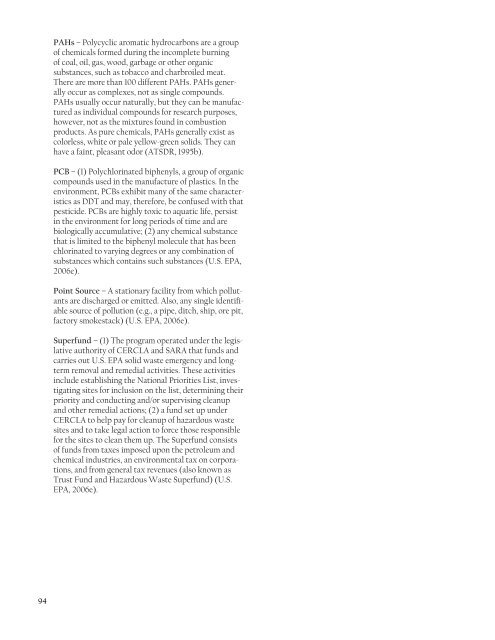Groundwater in the Great Lakes Basin
Groundwater in the Great Lakes Basin
Groundwater in the Great Lakes Basin
You also want an ePaper? Increase the reach of your titles
YUMPU automatically turns print PDFs into web optimized ePapers that Google loves.
PAHs – Polycyclic aromatic hydrocarbons are a group<br />
of chemicals formed dur<strong>in</strong>g <strong>the</strong> <strong>in</strong>complete burn<strong>in</strong>g<br />
of coal, oil, gas, wood, garbage or o<strong>the</strong>r organic<br />
substances, such as tobacco and charbroiled meat.<br />
There are more than 100 different PAHs. PAHs generally<br />
occur as complexes, not as s<strong>in</strong>gle compounds.<br />
PAHs usually occur naturally, but <strong>the</strong>y can be manufactured<br />
as <strong>in</strong>dividual compounds for research purposes,<br />
however, not as <strong>the</strong> mixtures found <strong>in</strong> combustion<br />
products. As pure chemicals, PAHs generally exist as<br />
colorless, white or pale yellow-green solids. They can<br />
have a fa<strong>in</strong>t, pleasant odor (ATSDR, 1995b).<br />
PCB – (1) Polychlor<strong>in</strong>ated biphenyls, a group of organic<br />
compounds used <strong>in</strong> <strong>the</strong> manufacture of plastics. In <strong>the</strong><br />
environment, PCBs exhibit many of <strong>the</strong> same characteristics<br />
as DDT and may, <strong>the</strong>refore, be confused with that<br />
pesticide. PCBs are highly toxic to aquatic life, persist<br />
<strong>in</strong> <strong>the</strong> environment for long periods of time and are<br />
biologically accumulative; (2) any chemical substance<br />
that is limited to <strong>the</strong> biphenyl molecule that has been<br />
chlor<strong>in</strong>ated to vary<strong>in</strong>g degrees or any comb<strong>in</strong>ation of<br />
substances which conta<strong>in</strong>s such substances (U.S. EPA,<br />
2006e).<br />
Po<strong>in</strong>t Source – A stationary facility from which pollutants<br />
are discharged or emitted. Also, any s<strong>in</strong>gle identifiable<br />
source of pollution (e.g., a pipe, ditch, ship, ore pit,<br />
factory smokestack) (U.S. EPA, 2006e).<br />
Superfund – (1) The program operated under <strong>the</strong> legislative<br />
authority of CERCLA and SARA that funds and<br />
carries out U.S. EPA solid waste emergency and longterm<br />
removal and remedial activities. These activities<br />
<strong>in</strong>clude establish<strong>in</strong>g <strong>the</strong> National Priorities List, <strong>in</strong>vestigat<strong>in</strong>g<br />
sites for <strong>in</strong>clusion on <strong>the</strong> list, determ<strong>in</strong><strong>in</strong>g <strong>the</strong>ir<br />
priority and conduct<strong>in</strong>g and/or supervis<strong>in</strong>g cleanup<br />
and o<strong>the</strong>r remedial actions; (2) a fund set up under<br />
CERCLA to help pay for cleanup of hazardous waste<br />
sites and to take legal action to force those responsible<br />
for <strong>the</strong> sites to clean <strong>the</strong>m up. The Superfund consists<br />
of funds from taxes imposed upon <strong>the</strong> petroleum and<br />
chemical <strong>in</strong>dustries, an environmental tax on corporations,<br />
and from general tax revenues (also known as<br />
Trust Fund and Hazardous Waste Superfund) (U.S.<br />
EPA, 2006e).<br />
94

















